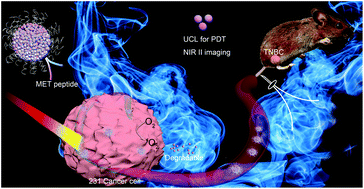MET-targeted NIR II luminescence diagnosis and up-conversion guided photodynamic therapy for triple-negative breast cancer based on a lanthanide nanoprobe†
Abstract
In this research, degradable peptide-modified upconversion nanoparticles (ZUPEA) were designed for the NIR II imaging and upconversion luminescence (UCL) guided photodynamic therapy (PDT) of triple-negative breast cancer (TNBC). Ultra-small rare-earth nanoparticles (RENPs) and the polymer mPEG-PLGA are polymerized into nano-microspheres via a double emulsion synthesis method, and a photosensitizer molecule (ZnPc) is added during the polymerization process to generate ZUPEA. Under 980 nm excitation, this strategy enhanced the red emission at 650 nm, showing an energy transfer efficiency of 38.3%, and the designed RENPs have better NIR II imaging abilities with a core@shell structure. These ZUPEA nanoparticles have good photodynamic therapeutic effects in vitro, and they can be degraded into small nanoparticles with a size of less than 6 nm. The cMBP-peptide-modified luminescent probe can recognize MDA-MB-231 TNBC cells in vivo when intravenously injected due to the positive targeted imaging effects of the cMBP peptide toward MET and negative targeted imaging effects relating to enhanced permeability and retention (EPR ). This specially designed ZUPEA probe with integrated diagnosis and treatment functionality provides new ideas and prospects for the use of rare-earth nanoparticles in the clinical treatment of tumors.



 Please wait while we load your content...
Please wait while we load your content...